Read about the impact VMFA Visual Arts Fellowships have had on these art professionals and students.
Daniel Turner: The Gift of Time to Explore His Work
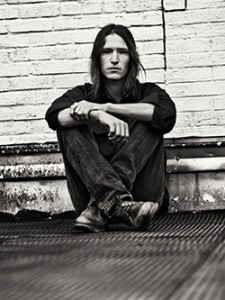
Portrait of Daniel Turner
While Fellowship recipients spend the dollars they’re awarded on a variety of different things—supplies, food, leave from work—the indirect benefit is almost always the same as it was for Daniel Turner. “It allowed me to pay even more attention to the work by easing some of the financial hardships . . . and granted me the most lucrative asset of any practice: time,” says Daniel Turner, who won two undergraduate Fellowships in 2004 and 2005, and went on to also win a professional Fellowship in 2008.
The artist, who now lives and works in New York City, began his career painting large-scale canvases but felt restricted by the two dimensions of the medium. In 2006, he burned all of his canvases and started fresh, working with more ordinary three-dimensional materials and objects, like industrial sinks and refrigerator handles, and distorting them in thought-provoking ways. With Turner’s subtle manipulation, a slowly rusting metal part in a sink or a steel wool rubbing on a gallery wall becomes a captivating piece of art. Recently, Turner was invited to do a residency at The Chinati Foundation in Marfa, Texas.
Winning those three Fellowships has had an “enormous, long-term impact” on both him and his work. He’s shown his work in solo and group exhibitions all over the world. Because Turner himself was motivated to submit that first application after hearing about Cy Twombly’s Fellowship, the artist has done his part to also spread the word to other artists. He estimates that he’s motivated at least a dozen artists to apply for Fellowships over the years.
“I’m fortunate enough to work full time as an artist,” he says, which he can credit, in no small part, to the Fellowships he won at VMFA.
Vince Gilligan: Intellectually and Financially Enriched by VMFA
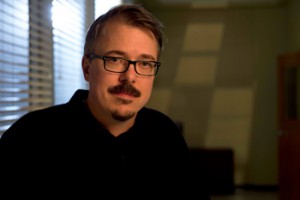
Vince Gilligan caption: Photo credit: “Frank Ockenfels 3/AMC”
“If I could go back in time and talk to my 15-year-old self, I would say ‘Smile a little, talk to people, and don’t be such a sheltered little nerd’.” Usually you don’t hear such honest self-reflection from anyone, let alone a world famous Hollywood producer, director, and writer! But Vince Gilligan is no ordinary celebrity. Despite winning awards (Writer’s Guild Awards and a Peabody, among others), and creating Breaking Bad, one of the most successful TV series currently airing (called “the best of the 21st century” by author Stephen King in 2009), Vince Gilligan is down-to-earth, and always true to his roots. He will be the first to tell you – “I’m a Virginian and I always will be.”
When talking with Gilligan on the phone, he immediately jumps into discussion of how much he loves VMFA, and how enriching it was to him growing up – both intellectually and financially. Gilligan was the recipient of two VMFA Fellowships in the 1980s, of which he says ““You could trace a direct line from Breaking Bad, back through X Files which I was on for seven years, back through college, and to the Virginia Museum and how inspirational it was to me and how much financial aid it gave me.” He also grew up visiting VMFA: “We loved spending hours there, even as little kids.” Gilligan kept this interest in the arts throughout his adolescence and in college, demonstrated through his studies in NYU film school, and through his college job of moving and handling fine art for private owners and galleries. Fans of Breaking Bad would appreciate the way Gilligan tells stories over the phone, with dry wit and comedic timing—one story in particular had him belly laughing in recollection. Once, he was tasked with moving a piece by John DeAndrea. If you’ve seen VMFA’s works by DeAndrea on view, you’ll understand the uncanny realism of the artist’s life-size human sculptures—and why Gilligan was worried he might be pulled over with one of these works, wrapped in plastic, in his truck!
Gilligan is genuine and endearing, and his passion for his work is evident. His advice to artists everywhere is above all, “always be true to yourself and… be true to the stories you truly want to tell”.
Will May, Photography Discipline/Graduate, Professional
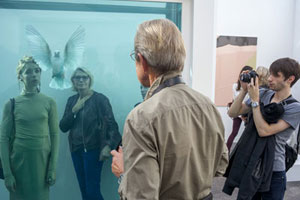
Will May (American, born 1964), Reassumption, 2012, archival pigment print.
In 2004, VCU graduate student Will May received a VMFA Visual Arts Fellowship. The award was of such benefit to him as a student that the photographer applied again, once he was established in his career in 2014 in the Professional category. And like 139 artists who have received multiple Fellowships in the 75-year history of the program, May took home a second award this year.
In the short-term, May has used the Fellowship funds he received to upgrade his equipment and materials, but the long-term impact has been much more profound. “Receiving an award like the Fellowship confers professional legitimacy, offers funds to experiment with and produce work that is free of commercial constraint, and generally boosts confidence,” says the photographer, who is also a stay-at-home dad.
The works that clinched May’s most recent award were eight pieces from his multi-year project Near & Far. As a child, May loved reading. “Images would constantly appear in my mind as I visualized myself in the story, seeing familiar locations and faces unknowable to the author,” he explains. As May matured, his imagination moved from fiction to real life. He started pondering how people overlay their own stories—who and where they are and what they’ve experienced—with what they know to be true. Capturing some of these narratives, Near & Far is likewise an invitation for the viewer to consider his or her own particular story. Ultimately, he hopes to compile the images from this photo series into a book.
Two works from this project, along with six other prints, will go on view this month at Richmond International Airport as part of VMFA’s 75th anniversary Fellowship exhibition.
Megan Holley, Film/Video Discipline/Professional
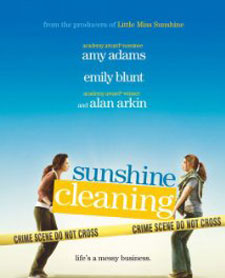
Courtesy of Overture Films
It’s one thing to be really good at something; it’s often quite another to make a career out of it.
Screenwriter and consummate storyteller Megan Holley was at just such a crossroads in the early 2000s. “I had always wanted to be a filmmaker and storyteller but lacked the confidence to throw myself into the deep end,” she recalls. “I had a very clear sense that if I didn’t push hard to realize my dreams then, I never would. I would settle. I would always love film, but I would remain an observer and not a participant.”
Then she won a VMFA Visual Arts Fellowship for screenwriting in 2002, and everything changed. The award gave her not only the funds to move forward on a feature film that she was directing, but also the courage to stop testing the waters and dive in head first.
That year, Holley wrote the screenplay for what would become the critically acclaimed film Sunshine Cleaning. Screened at the Sundance Film Festival and released theatrically, the film also earned her the “Best Woman Storyteller” award from the Women Film Critics Circle Awards. Since then, she’s gone on to pen scripts for Fox 2000, Paramount, ABC, Showtime, and Bad Robot and worked closely with many of her heroes, including Robert Zemeckis, Ron Howard, and J.J. Abrams.
Despite the fact that Holley spends a lot of time on studio lots these days (“I still get a thrill every time I drive onto a studio lot”), she continues to call Richmond home. And while she’s in the River City, the screenwriter regularly visits VMFA; you might even find her writing in Best Café now and again.
But it’s not just because Holley loves the art here. The museum also represents a turning point for her. She says: “The VMFA award helped give me the confidence to set aside my fears and jump.”
Nick Kuszyk, Mixed Media Discipline/Undergrad Fellowship
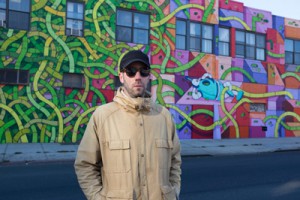
Kuszyk portrait/Bronx Mural. Photographer: Jonathan Mehring
VMFA doesn’t award Fellowships to only those creating traditional art. Take Nick Kuszyk, for example. This artist, who won a Fellowship in 2002, creates murals or what’s commonly known as “street art” in New York City; Richmond, where he went to VCU School of the Arts; and other locations around the world.
“The Fellowship has remained to this day a point of personal confidence that has been valuable on paper and inside my soul,” says Kuszyk, whose murals enliven city streets with their bold colors and very expressive robots. “I think it is very important to have institutions support artists in a monetary fashion. It matters immensely.”
In fact, the artist paid part of his Fellowship funds forward taped to the backs of 1,000 paintings at a show in Richmond.
Jack Wax, Crafts Discipline/Professional Fellowship
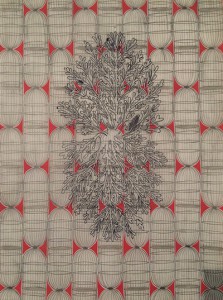
Bracken, Jack Wax. Image courtesy of the artist
Professor Jack Wax, who teaches at the VCU School of the Arts, used his Fellowship funds in 2007 to take a research leave of absence and work at three consecutive artists’ residencies (Jentel, Ucross, and The Kohler ARTS/industry residency) for several months.
“In those residency programs I began a mode (and method) of working on detailed drawings that spring from my obsession with the ‘impossible’ balancing act that we engage in everyday . . . ,” Wax explains. “This has had a lasting and long-term effect on my studio practice.” These days, the artist is teaching and also exhibiting internationally, including at The Smithsonian Institute, LA County Museum, Toyama City Japan, Ibaraki City Japan, and Cam Ocagi Istanbul Turkey.
And of course, he continues to produce work. Of his recent creations, Wax says, “I have been deeply engaged in, and involved with the generation of images in the illusionary space of the two-dimensional plane.”
Alyssa Salomon: Photography Discipline/Professional Fellowship
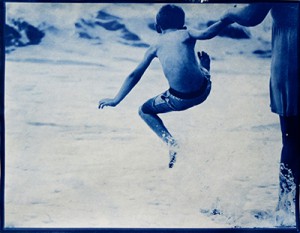
Terrors & pleasures, with training wheels, Alyssa Salomon. Image courtesy of the artist
Winning VMFA Visual Arts Fellowships in 2000 and 2009 showed photographer and printmaker Alyssa Salomon that “what I was making, what I was exploring, what I was thinking had merit, was worth continuing to make, to explore, to think.”
Using the funds from the first award to learn to make daguerreotypes and buy the supplies and equipment, Salomon became the only woman and one of only a dozen or so active daguerreotypists at the time. She exhibited her work nationally and also shared her knowledge of the medium with photographers, art historians, and collectors.
The second Fellowship allowed this artist to explore using handmade photographic processes to make large prints. “With these technical explorations, I again found my work shifting to a new level,” she says. Since that time, Salomon has exhibited her photography and printmaking nationally and internationally and continues taking intellectual and aesthetic risks with her art. According to Salomon, the awards encouraged her to stretch herself. “I took courage to push harder and further and faster, with intellectual and aesthetic risk.”
Amy Harris: Painting Discipline/Undergrad Fellowship
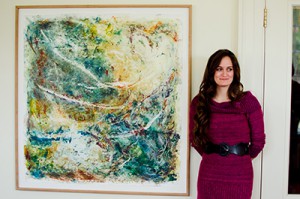
SM-AF, Amy Harris. Photographer: Kim Leonard
In 2011, Amy Harris’s intermediate sculpture teacher at Virginia Tech asked all of his students to apply for a VMFA Visual Arts Fellowship. “Not only does it encourage you to stay on top of your studio organization, but preparing for a Fellowship makes you honestly evaluate your work’s current state and whether or not that state holds enough weight professionally,” says the 2013 grad, who ended up winning a Fellowship in 2012.
After receiving the award, Harris had her first solo exhibition at VMFA’s Pauley Center, and during that exhibition, her gallery representative arranged an Artist Talk for her at VMFA. “Engaging with the public in an art setting and hearing others’ opinions and ideas is always an interesting experience.
This talk was a great introductory step into the professional art world,” she adds. Currently, she is preparing for multiple shows and will be continuing her education in the future.
Jessica Wheat Welton, Art History Discipline/Graduate Fellowship
VMFA knows that art historians need support as much as those who are creating the art itself. Jessica Wheat Welton, who was researching and writing her dissertation on Native American art—and specifically the work of Hopi painter Fred Kabotie—at the time of the Fellowship she received in 2008, used the funds to dig deeper into this subject and to pay for her travel to several institutions across the country.
“Kabotie’s work had never been looked at in light of the American or modernist movement, and this grant enabled me to establish connections between Kabotie and these groups,” says Welton, who was subsequently a Scholar in Residence at the Amerind Foundation in Arizona.
In November of 2014, the art historian successfully defended her dissertation. This body of work will serve as the subject of an upcoming exhibition and book.
Sally Bowring, Painting Discipline/Professional Fellowship
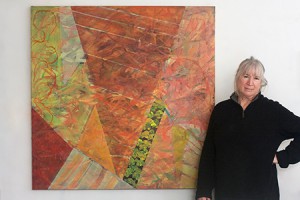
Autumn, 2014, Sally Bowring, acrylic, 48″ x 48″. Image courtesy of the artist
When Sally Bowring, a painter and advisor/instructor at VCU School of the Arts, was awarded a Fellowship in 2003, she felt a sense of validation for her work and even her status as an artist. “It was clearly a ‘leg-up’ to be able to add this honor to my resume,” she says. “I do believe the honor added status to my exhibition record at Reynolds Gallery (in Richmond, Virginia) and maybe helped my sales as well.”
Throughout her more than 40-year career, Bowring has exhibited her work extensively across the country, including the Bronx River Art Center; Touchstone Gallery, Washington, D.C.; ARC Gallery, Chicago; The Painting Center, New York; and The Florida Museum of Hispanic and Latin American Art, Miami as well as in Korea, Peru, Italy, and Canada.
Most recently Bowring received an Adjunct Faculty Grant to create and build an installation at the Rawls Museum Arts in Courtland, Virginia, and she has served as co-curator to a travelling non-representational 11-artist exhibition called Constructs. “We have received a grant from the VCA for a catalog (for this exhibition), and, we have shown at numerous Virginia venues for the past five years,” Bowring proudly notes.
Kris Iden, Printmaking Discipline/Professional Fellowship
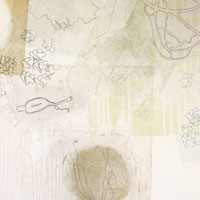
A second, a pearl (2) (detail), 2013, Multiple plate color intaglio. Image courtesy of the artist
Most Fellowship recipients feel the impact of their Fellowships for years, perhaps even throughout their careers. However, few have the tangible reminder of that impact that printmaker and educator Kris Iden has.
After winning a Fellowship in 2000, Iden purchased a press with part of the funds from her award. And for the past fifteen years, Iden has moved that press around with her, even to Dresden, Germany, and the equipment has helped to advance her career a little further with every mile it’s traveled.“Without the press, I would not have had the opportunity to develop my work in printmaking and my exhibition activity to its current level,” she says.
Since winning her Fellowship, Iden has had nine solo exhibitions as well as been a part of numerous group shows, several of which have been held at international art spaces. Her work will also be included in the VMFA Fellowship 75th Anniversary exhibition, opening this summer at the Pauley Center.
But the impact of Iden’s Fellowship runs much deeper than the press she purchased or even the finished products that have come off it. According to Iden, “The mere acknowledgment for one’s work is something for which I have been deeply grateful.”
Josephine Haden, Painting Discipline/Professional Fellowship
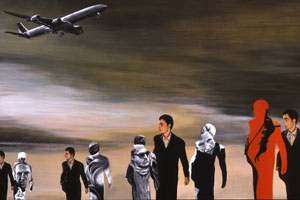
Team Members Only (detail), 24 x 48 in. Image courtesy of the artist.
Winning a VMFA Fellowship in 2008 was a significant achievement for painter Josephine Haden, but also being one of the first winners to have her work on view at VMFA as part of the debut of the Fellowship Exhibitions Program gave that honor even greater impact.
“The Pauley Center exhibition brought me considerable professional attention, which is an opportunity that most artists dream of—a solo show in a prestigious museum,” says Haden, who also exhibited her work at Richmond International Airport as part of this program.
At the time of her award, the recession was beginning to take hold and sales of her paintings were dropping off; therefore, these accolades and public exposure definitely came at a good time. As a result, Haden, who paints landscapes “on the edge of reality,” was asked to exhibit her paintings in a solo exhibition at the Barry Gallery at Marymount University in Arlington; the Denise Bibro Fine Art Gallery in Chelsea, New York; and the Reynolds Gallery in Richmond. She was also selected as a Showcase Winner and Juried Winner by ArtSlant, a contemporary art network.
Not only that, the award gave Haden the funds to enroll in classes and purchase Final Cut Pro software that allowed her to explore a new direction for her art. With these resources at her disposal, the artist began integrating her traditional paintings with art videos, essentially animating her work.
“The VMFA grant allowed me to put more time into breaking into a new way to create interface between the two-dimensional and three-dimensional space and to play with animated and static images,” says Haden, “It pushed my art into new frontiers.”